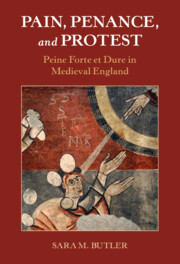Book contents
- Pain, Penance, and Protest
- Studies in Legal History
- Pain, Penance, and Protest
- Copyright page
- Contents
- Tables
- Acknowledgments
- Table of Statutes
- Abbreviations
- Introduction
- 1 Peine Forte et Dure: The Medieval Practice
- 2 Standing Mute in the Courts of Medieval England
- 3 Due Process and Consent to Jury Trial
- 4 Peine Forte et Dure as Barbarity? Putting the Practice in Context
- 5 Why Stand Mute?
- 6 Standing Mute as Imitatio Christi
- 7 Rejecting the Jury, Rejecting the Common Law, Rejecting the King
- Conclusion
- Bibliography
- Index
4 - Peine Forte et Dure as Barbarity? Putting the Practice in Context
Published online by Cambridge University Press: 19 November 2021
- Pain, Penance, and Protest
- Studies in Legal History
- Pain, Penance, and Protest
- Copyright page
- Contents
- Tables
- Acknowledgments
- Table of Statutes
- Abbreviations
- Introduction
- 1 Peine Forte et Dure: The Medieval Practice
- 2 Standing Mute in the Courts of Medieval England
- 3 Due Process and Consent to Jury Trial
- 4 Peine Forte et Dure as Barbarity? Putting the Practice in Context
- 5 Why Stand Mute?
- 6 Standing Mute as Imitatio Christi
- 7 Rejecting the Jury, Rejecting the Common Law, Rejecting the King
- Conclusion
- Bibliography
- Index
Summary
Chapter 4 argues in favor of seeing medieval justice as penitential justice with the ultimate goal of spiritual reform. Medieval society blurred the lines between sin and crime, penance and punishment. Recognizing this distortion is how one makes sense of peine forte et dure. Pain as an experience is key to the performance of penance. Through physical pain, the disordered soul is righted and the sinner gains entrance to heaven. Fasting, seclusion, denial of luxuries – these are all ascetic practices with a long association with Christian penance. Even pressing with weights appears as a penitential practice in numerous sermon stories from the era. Exposing the uncooperative sinner to an ascetic lifestyle, even if it was against his wishes, was in the best interests of the defendant’s soul. As a coercive measure, it helped to begin the process of purging his sin before he agreed to place himself in the hands of the jury. As such, he displayed to jurors his willingness to reform his ways and reconcile with the Christian community.
- Type
- Chapter
- Information
- Pain, Penance, and ProtestPeine Forte et Dure in Medieval England, pp. 188 - 249Publisher: Cambridge University PressPrint publication year: 2021

